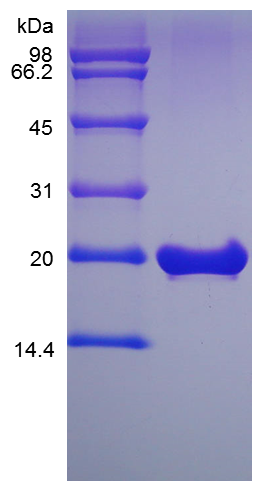- Synonyms
- zFGF5
- Source
- Escherichia coli.
- Molecular Weight
- Approximately 21.0 kDa, a single non-glycosylated polypeptide chain containing 180 amino acids.
- AA Sequence
- EENVDFRIHV ENQTRARDDV SRKQLRLYQL YSRTSGKHIQ VLGRRISARG EDGDKYAQLL VETDTFGSQV RIKGKETEFY LCMNRKGKLV GKPDGTSKEC VFIEKVLENN YTALMSAKYS GWYVGFTKKG RPRKGPKTRE NQQDVHFMKR YPKGQAELQK PFKYTTVTKR SRRIRPTHPG
- Purity
- > 95 % by SDS-PAGE and HPLC analyses.
- Biological Activity
- Fully biologically active when compared to standard. The ED50 as determined by thymidine uptake assay using FGF-receptors transfected BaF3 cells is less than 0.5 ng/ml, corresponding to a specific activity of > 2.0 × 106 IU/mg.
- Physical Appearance
- Sterile Filtered White lyophilized (freeze-dried) powder.
- Formulation
- Lyophilized from a 0.2 µm filtered concentrated solution in PBS, pH 7.4, 500 mM NaCl.
- Endotoxin
- Less than 1 EU/µg of rMuFGF-18 as determined by LAL method.
- Reconstitution
- We recommend that this vial be briefly centrifuged prior to opening to bring the contents to the bottom. Reconstitute in sterile distilled water or aqueous buffer containing 0.1 % BSA to a concentration of 0.1-1.0 mg/ml. Stock solutions should be apportioned into working aliquots and stored at ≤ -20 °C. Further dilutions should be made in appropriate buffered solutions.
- Stability & Storage
- Use a manual defrost freezer and avoid repeated freeze-thaw cycles.
- 12 months from date of receipt, -20 to -70 °C as supplied.
- 1 month, 2 to 8 °C under sterile conditions after reconstitution.
- 3 months, -20 to -70 °C under sterile conditions after reconstitution.
- Usage
- This material is offered by Shanghai PrimeGene Bio-Tech for research, laboratory or further evaluation purposes. NOT FOR HUMAN USE.
- SDS-PAGE

- Reference
- 1. Ohbayashi N, Hoshikawa M, Kimura S, et al. 1998. J Biol Chem. 273:18161-4.
2. Hu MC, Qiu WR, Wang YP, et al. 1998. Mol Cell Biol. 18:6063-74.
3. Itoh N, Ornitz DM. 2004. Trends Genet. 20:563-9.
4. Itoh N. 2007. Biol Pharm Bull. 30:1819-25.
5. Liu Z, Xu J, Colvin JS, et al. 2002. Genes Dev. 16:859-69.
6. Ohbayashi N, Shibayama M, Kurotaki Y, et al. 2002. Genes Dev. 16:870-9.
7. Usui H, Shibayama M, Ohbayashi N, et al. 2004. Biochem Biophys Res Commun. 322:887-92.
8. Ellsworth JL, Berry J, Bukowski T, et al. 2002. Osteoarthritis Cartilage. 10:308-20.
9. Moore EE, Bendele AM, Thompson DL, et al. 2005. Osteoarthritis Cartilage. 13:623-31.
- Background
- Murine FGF-18 is encoded by the FGF18 gene. By phylogenetic analysis and gene location analysis, FGF-18 is divided into FGF-8 subfamily which has three members FGF-8, FGF-17 and FGF-18. Using FGF knockout mice model, the numbers of this subfamily were testified that have crucial roles of in embryo development. FGF-18–/– mice have decreased expression of osteogenic markers and delayed long-bone ossification. FGF-18 has been shown in vitro that this protein is able to induce neurite outgrowth in PC12 cells. In addition, it also has significant roles in lung development and has an anabolic effect on cartilage formation.









 COA Application
COA Application


